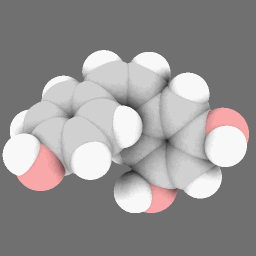Aging Research
| Scientists have found that a fundamental new mechanism for the known beneficial effects of resveratrol: it powerfully activates an evolutionarily ancient stress responses in human cells. |
| |
Researchers at The Scripps Research Institute (TSRI) have found that resveratrol, the red-wine ingredient once touted as an elixir of youth, powerfully activates an evolutionarily ancient stress response in human cells.
The finding, published in the journal Nature should dispel much of the mystery and controversy about how resveratrol really works.
"With these findings we have a new, fundamental mechanism for the known beneficial effects of resveratrol." |
“With these findings we have a new, fundamental mechanism for the known beneficial effects of resveratrol,” said lead author Mathew Sajish, a senior research associate in the Schimmel laboratory.
 |
| Resveratrol was first isolated from Senna quinquangulata Image Source - Wikipedia |
Resveratrol is a compound produced in grapes, cacao beans, Japanese knotweed and some other plants in response to stresses including infection, drought and ultraviolet radiation. It has attracted widespread scientific and popular interest over the past decade, as researchers have reported that it extended lifespan and prevented diabetes in obese mice and vastly increased the stamina of ordinary mice running on wheels.
 |
| Image Source - Mathew Sajish & Paul Schimmel/Nature |
| Related articles |
The researchers began to find hints that a tRNA synthetase called TyrRS, which links the amino acid tyrosine to the genetic material that codes for it, can move to the cell nucleus under stressful conditions—apparently taking on a protective, stress-response role. Sajish noted that resveratrol appeared to have broadly similar stress-response properties and also resembled TyrRS’s normal binding partner tyrosine. “I began to see TyrRS as a potential target of resveratrol,” he said.
For the new study, Sajish and Schimmel put TyrRS and resveratrol together and showed with tests including X-ray crystallography that resveratrol does indeed mimic tyrosine, well enough to fit tightly into TyrRS’s tyrosine binding pocket. That binding to resveratrol, the team found, takes TyrRS away from its protein translation role and steers it to a function in the cell nucleus.
Tracking the resveratrol-bound TyrRS in the nucleus, the researchers determined that it grabs and activates the protein, PARP-1, a major stress response and DNA-repair factor thought to have a significance influence on lifespan. The scientists confirmed the interaction in mice injected with resveratrol. TyrRS’s activation of PARP-1 led, in turn, to the activation of a host of protective genes including the tumor-suppressor gene p53 and the longevity genes FOXO3A and SIRT6.
The first studies of resveratrol, by David Sinclair and others had suggested that it exerts some of its positive effects on health by activating SIRT1, also thought to be a longevity gene. But SIRT1’s role in mediating resveratrol’s reported health-boosting effects has been questioned lately in terms of its particular role.
The latest experiments showed, however, that the TyrRS-PARP-1 pathway can be measurably activated by much lower doses of resveratrol—as much as 1,000 times lower—than were used in some of the more celebrated prior studies, including those focused on SIRT1. “Based on these results, it is conceivable that moderate consumption of a couple glasses of red wine (rich in resveratrol) would give a person enough resveratrol to evoke a protective effect via this pathway,” Sajish said. He also suspects that effects of resveratrol that only appear at unrealistically high doses may have confounded some prior findings.
“We believe that TyrRS has evolved to act as a top-level switch or activator of a fundamental cell-protecting mechanism that works in virtually all forms of life,” said Sajish.
Whatever activity resveratrol
“We think this is just the tip of the iceberg,” said Schimmel. “We think there are a lot more amino-acid mimics out there that can have beneficial effects like this in people. And we’re working on that now.”
SOURCE Scripps Research Institute
| By 33rd Square | Embed |




0 comments:
Post a Comment